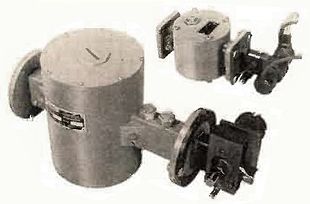
Back Cavitat de microones Catalan Cavidad resonante Spanish Cavité micro-ondes French सूक्ष्मतरंग कोटर Hindi

A microwave cavity or radio frequency cavity (RF cavity) is a special type of resonator, consisting of a closed (or largely closed) metal structure that confines electromagnetic fields in the microwave or RF region of the spectrum. The structure is either hollow or filled with dielectric material. The microwaves bounce back and forth between the walls of the cavity. At the cavity's resonant frequencies they reinforce to form standing waves in the cavity. Therefore, the cavity functions similarly to an organ pipe or sound box in a musical instrument, oscillating preferentially at a series of frequencies, its resonant frequencies. Thus it can act as a bandpass filter, allowing microwaves of a particular frequency to pass while blocking microwaves at nearby frequencies.
A microwave cavity acts similarly to a resonant circuit with extremely low loss at its frequency of operation, resulting in quality factors (Q factors) up to the order of 106, for copper cavities, compared to 102 for circuits made with separate inductors and capacitors at the same frequency. For superconducting cavities, quality factors up to the order of 1010 are possible. They are used in place of resonant circuits at microwave frequencies, since at these frequencies discrete resonant circuits cannot be built because the values of inductance and capacitance needed are too low. They are used in oscillators and transmitters to create microwave signals, and as filters to separate a signal at a given frequency from other signals, in equipment such as radar equipment, microwave relay stations, satellite communications, and microwave ovens.
RF cavities can also manipulate charged particles passing through them by application of acceleration voltage and are thus used in particle accelerators and microwave vacuum tubes such as klystrons and magnetrons.
© MMXXIII Rich X Search. We shall prevail. All rights reserved. Rich X Search